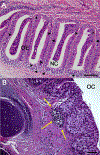The evolution of nasal immune systems in vertebrates
- PMID: 26391349
- PMCID: PMC6056724
- DOI: 10.1016/j.molimm.2015.09.008
The evolution of nasal immune systems in vertebrates
Abstract
The olfactory organs of vertebrates are not only extraordinary chemosensory organs but also a powerful defense system against infection. Nasopharynx-associated lymphoid tissue (NALT) has been traditionally considered as the first line of defense against inhaled antigens in birds and mammals. Novel work in early vertebrates such as teleost fish has expanded our view of nasal immune systems, now recognized to fight both water-borne and air-borne pathogens reaching the olfactory epithelium. Like other mucosa-associated lymphoid tissues (MALT), NALT of birds and mammals is composed of organized lymphoid tissue (O-NALT) (i.e., tonsils) as well as a diffuse network of immune cells, known as diffuse NALT (D-NALT). In teleosts, only D-NALT is present and shares most of the canonical features of other teleost MALT. This review focuses on the evolution of NALT in vertebrates with an emphasis on the most recent findings in teleosts and lungfish. Whereas teleost are currently the most ancient group where NALT has been found, lungfish appear to be the earliest group to have evolved primitive O-NALT structures.
Keywords: Evolution; Mucosal immunity; NALT; Nasal immunity; Teleost fish; Vertebrates.
Copyright © 2015 Elsevier Ltd. All rights reserved.
Figures


References
-
- Ache BW, Young JM, 2005. Olfaction: diverse species, conserved principles. Neuron 48, 417–430. - PubMed
-
- Adachi S, Yoshida H, Honda K, Maki K, Saijo K, Ikuta K, Saito T, Nishikawa S-I, 1998. Essentia role of IL-7 receptor alpha in the formation of Peyer’s patch anlage. Int. Immunol 10 (1), 1–6. - PubMed
-
- Ansel KM, Ngo VN, Hyman PL, Luther SA, Förster R, Sedgwick JD, Browning JL, Lipp M, Cyster JG, 2000. A chemokine-driven positive feedback loop organizes lymphoid follicles. Nature 406, 309–314. - PubMed
-
- Asanuma H, Hodson Thompson A, Iwasaki T, Sato Y, Inaba Y, Aizawa C, Kurata T, Tamura S.-i.-, 1997. Isolation and characterization of mouse nasal-associated lymphoid tissue. J. Immunol. Methods 202, 123–131. - PubMed
-
- Bailey M, Haverson K, Inman C, Harris C,Jones P, Corfield G, Miller B, Stokes C, 2005. The development of the mucosal immune system pre-and post-weaning: balancing regulatory and effector function. Proc. Nutr. Soc 64, 451–457. - PubMed
Publication types
MeSH terms
Grants and funding
LinkOut - more resources
Full Text Sources
Other Literature Sources

